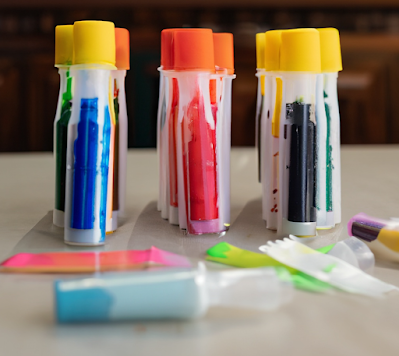Your kitchen countertop is not only a functional surface but also a focal point of your kitchen's aesthetic appeal. However, certain foods and substances have the potential to leave stubborn stains if not handled with care. We'll explore some of the worst offenders when it comes to staining kitchen countertops, and help you eliminate them when they show up. By understanding the risks associated with these items, you can take proactive measures to protect and maintain the beauty of your countertop.
 |
| Unattended stains can turn into a Monster that you may need a professional to remove. In some cases, even an exorcist may not be able to help. |
Red Wine
Red wine, known for its rich colour and tannins, is notorious for causing stains on various countertop materials. Its deep pigments can penetrate porous surfaces, leaving behind unsightly marks. Promptly wiping up spills and using protective coasters can help minimize the risk of red wine stains.
Mustard
Mustard, with its vibrant yellow hue, contains potent natural dyes that can be problematic for countertops. Whether it's a hot dog mishap or a sandwich gone wrong, mustard stains can be stubborn and difficult to remove. Quick action with mild cleaning solutions and gentle scrubbing is key to preventing lasting stains.
Beet Juice
Beet juice, celebrated for its vibrant colour and health benefits, can pose a staining challenge for kitchen countertops. The intense red pigment of beets has the potential to leave behind noticeable stains. Immediate cleaning and blotting with mild dish soap and water can help prevent beet juice stains from setting in.
Turmeric
Turmeric, a popular spice known for its vibrant yellow colour and health properties, can wreak havoc on light-coloured countertops. Its potent dye can easily transfer onto surfaces and create stubborn stains. Promptly cleaning up turmeric spills with a mixture of mild soap and water is essential to prevent staining.
Food Dyes
Artificial food dyes, commonly found in candies, beverages, and baked goods, can present staining risks for kitchen countertops. Brightly coloured dyes, such as those used in candies and frostings, have the potential to leave lasting stains if not cleaned promptly. Diligent and immediate cleaning with gentle cleaning solutions is crucial to minimize the risk of staining.
What should you do to eliminate stains?
To eliminate stains from your kitchen countertop, follow these steps:
- Act quickly: Address stains as soon as possible to prevent them from setting into the surface.
- Identify the type of stain: Determine the nature of the stain, whether it's from food, liquid, or other substances, as different stains may require specific treatment methods.
- Blot or scrape: Use a clean cloth or plastic scraper to gently blot or scrape away any excess stain or residue.
- Use a mild cleaner: Apply a mild cleaner specifically designed for your countertop material. Avoid using harsh or abrasive cleaners that can damage the surface.
- Scrub gently: Use a soft sponge or non-abrasive scrub brush to gently scrub the stained area in a circular motion. Avoid using excessive force that could scratch the surface.
- Rinse thoroughly: After scrubbing, rinse the area with clean water to remove any remaining residue or cleaner.
- Dry completely: Ensure the countertop is completely dry to prevent any moisture-related issues or potential for future stains.
- Repeat if necessary: For stubborn stains, you may need to repeat the cleaning process or try alternative stain removal methods recommended for your specific countertop material. We recommend Barkeeper's Friend for smooth surfaces or Dawn Powerwash for suede, honed, leathered or generally matte finish.
Check out our blog post on how to perform a test whenever you need to seal your stone.
NEVER EVER USE MAGIC ERASER!
Magic eraser is abrasive and will dull the finish of your stone.
There are other potential culprits such as dark coffee or tea, tomato-based sauces, berries, and curry. They can penetrate the porous natural stones, thus increasing the importance of keeping them sealed. Light colour quartz is also prone to staining and removing the stains can be very tough even for professionals.
Protecting your kitchen countertop from potential staining agents is essential to maintain its beauty and longevity. Being aware of the staining risks associated with dark pigments, high acidity, and bright colours empowers you to take proactive measures. Promptly cleaning up spills, using coasters, and employing gentle cleaning methods will help preserve the pristine appearance of your kitchen countertop. Remember, prevention is the key to keeping your countertop looking its best for years to come.






